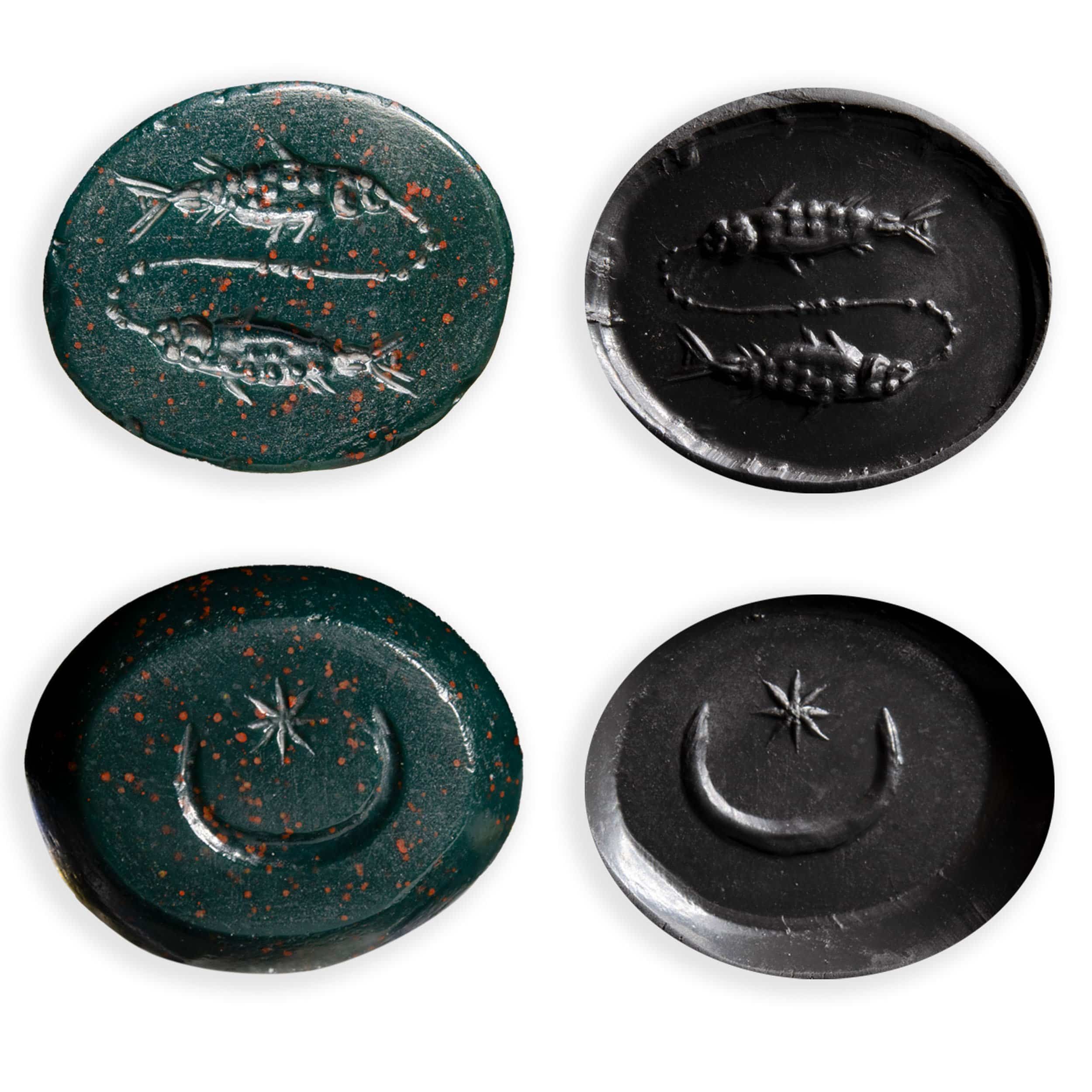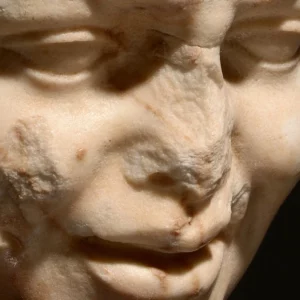Heliotrope
Dim_ 1,7 x 2,1 x 0,4 cm
Art romain, II ème - III ème siècle
La pierre aux larges dimensions est gravée sur la face principale deux poissons l'un en haut, l'autre en bas nageant en sens opposé et reliés entre eux par un cordon décoré d'éléments globulaires.
Sur l'autre face, un croissant de lune et une étoile à 7 branches. Gemme gnostique-astrologique en référence à la constellation des Poissons.
La constellation des Poissons est une des plus anciennes. Son origine remonte vraisemblablement aux Babyloniens qui la décrivaient déjà comme composée de deux poissons poussant un œuf géant (l'astérisme de "l'Anneau"). Pour les égyptiens il s'agit du poisson inet, dans lequel se réfugie l'âme des défunts.
Effectivement les Poissons nous immergent dans le domaine du religieux puisque l'astrologie classique en fait le signe du Christ et des mystiques. Dans ce signe divin, l'unité est loi: les Poissons symbolisent l'unité divine.
Dans de nombreuses mythologies, les différentes divinités des Poissons montrent que cette unité divine, l'être humain en fait l'expérience au tout début de sa vie, quand il est encore un fœtus dans le ventre maternel (le cordon reliant les poissons entre-eux pourrait faire référence au cordon ombilical).
Ici l'usage de l'héliotrope est à assimiler avec la représentation de ce signe astrologique pour comprendre la fonction de cette gemme. D'après Pline l'Ancien l'une des principales utilisations de cette pierre était pour influencer le climat ou invoquer les tempêtes lorsque celle-ci était placée dans de l'eau sous les rayons solaires.
Le symbole des poissons faisant aussi référence au dieu des mers et océans Neptune, il pourrait s'agir d'une pierre à usage ésotérique.
Provenance:
Collection privée française
Ancienne collection anglaise
A ROMAN BLOODSTONE ASTROLOGICAL GNOSTIC INTAGLIO. PISCES. 2ND-3RD CENTURY A.D.
0,7 x 0,8 x 0,1 in. Dim
The large-sized stone is engraved on the principal face with two fishes, one at the top, the other at the bottom swimming in the opposite direction and linked together by a cord decorated with globular elements.
On the other side, a crescent moon and a 7-pointed star. Gnostic-astrological gem with reference to the Pisces constellation.
The Pisces constellation is one of the oldest. Its origin probably dates back to the Babylonians who already described it as composed of two fishes pushing a giant egg (the asterism of "the Ring"). For the Egyptians it is the inet fish, in which the soul of the deceased takes refuge.
Indeed, Pisces immerses us in the realm of religion since classical astrology makes it the sign of Christ and of the mystics. In this divine sign, unity is law: Pisces symbolizes divine unity.
In many mythologies, the different deities of Pisces show that this divine unity, the human being experiences at the very beginning of his life, when he is still a foetus in the maternal womb (the cord connecting the fishes between- they could refer to the umbilical cord).
Here the use of the heliotrope is to be assimilated with the representation of this astrological sign to understand the function of this gem. According to Pliny the Elder one of the main uses of this stone was to influence the climate or to invoke storms when it was placed into water under the sun's rays.
The symbol of the Pisces also refers to the god of the seas and oceans Neptune, hence it could be a stone for esoteric use.
Description complète







